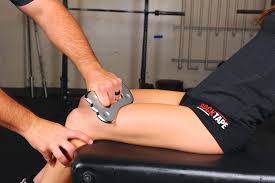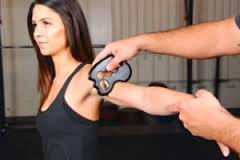
Scraping is done when a tool is used to “scrape” over a muscle or sore spot to help move toxins out, break up scar tissue or get rid of tendonitis. ”Sha” is best defined as the red splotches or petechia that appear on the skin from rubbing the spoon or tool repeatedly over the affected area.
The Graston Technique is a form of manual therapy known as soft-tissue instrument-assisted mobilization. It is one of a number of manual therapy approaches that use instruments with a specialized form of massage/scraping the skin gently.
IASTM stands for Instrument Assisted Soft Tissue

Instrument Assisted Soft Tissue Mobilisation or Simply IASTM is a new range of tool which enables clinicians to efficiently locate and treat individuals diagnosed with soft tissue dysfunction. The technique itself is said to be a modern evolution from Traditional Chinese Medicine called Gua Sha[1].However Gua Sha was not used to treat Musculoskeletal conditions but was traditionally applied along meridiens to move the bad chi out through the skin.IASTM is a is a procedure that is rapidly growing in popularity due to its effectiveness and efficiency while remaining non-invasive,with its own indications and limitations.
IASTM is performed with ergonomically designed instruments that detect and treat fascial restrictions, encourage rapid localization and effectively treat areas exhibiting soft tissue fibrosis, chronic inflammation, or degeneration. As in any Manual therapy treatment ,supplementation with exercises and additional modalities e.g. joint mobilization designed to correct biomechanical deficiencies by addressing musculoskeletal strength and muscle imbalances throughout the entire kinetic chain should be used in conjunction with IASTM.
How does it work?
Instruments effectively break down fascial restrictions and scar tissue. The ergonomic design of these instruments provides the clinician with the ability to locate restrictions and allows the clinician to treat the affected area with the appropriate amount of pressure.
The introduction of controlled microtrauma to affected soft tissue structure causes the stimulation of a local inflammatory response. Microtrauma initiates reabsorption of inappropriate fibrosis or excessive scar tissue and facilitates a cascade of healing activities resulting in remodeling of affected soft tissue structures. Adhesions within the soft tissue which may have developed as a result of surgery, immobilization, repeated strain or other mechanisms, are broken down allowing full functional restoration to occur.[2][3][4]
Indications
- Limited motion
- pain during motion
- motor control issues
- Muscle recruitment issues
Conditions for which IASTM is usually used:
- Medial Epicondylitis, Lateral Epicondylitis
- Carpal Tunnel Syndrome
- Neck Pain
- Plantar Fascitis
- Rotator Cuff Tendinitis
- Patellar Tendinitis
- Tibialis Posterior Tendinitis
- Heel Pain /Achilles Tendinitis
- DeQuervain’s Syndrome
- Post-Surgical and Traumatic Scars
- Myofascial Pain and Restrictions
- Musculoskeletal Imbalances
- Chronic Joint Swelling Associated with Sprains/Strains
- Ligament Sprains
- Muscle Strains
- Non-Acute Bursitis
- RSD (Reflex Sympathetic Dystrophy)
- Back Pain
- Trigger Finger
- Hip Pain (Replacements)
- IT Band Syndrome
- Shin Splints
- Chronic Ankle Sprains
- Acute Ankle Sprains (Advanced Technique)
- Scars (Surgical, Traumatic)
